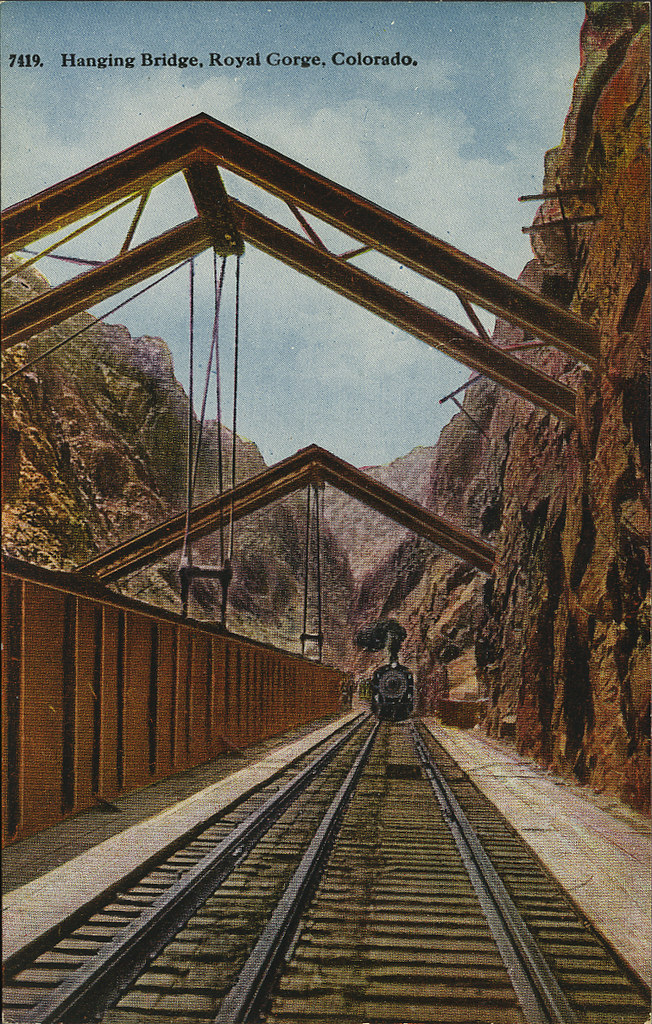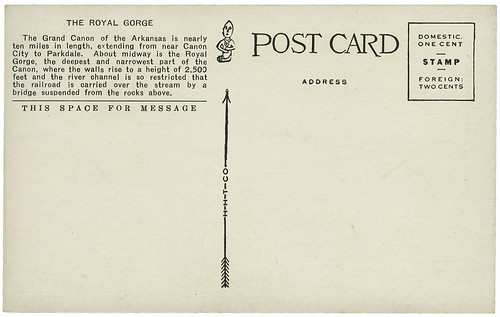I'm in a mood for trains, riding the rails, hearing the far off steam engine whistle. This happens every so often and I just have to let it slide because I don't live anywhere near trains. I have to just shut my eyes and imagine it.
The reason this cropped up again is because of my post yesterday at my vernacular photography blog about the Pennsylvania Railroads steam locomotive the S1. I found a photo of it at the 1939 World's Fair within a box at an estate sale.
The train below is not as stunning as the S1, but it has a fine history.
Click on image to see it larger.
In the late 1870s miners descended on the upper Arkansas River valley of Colorado in search of carbonate ores rich in lead and silver. The feverish mining activity in what would become the Leadville district attracted the attention of the Denver & Rio Grande Western Railroad and the Atchison, Topeka, and Santa Fe Railway, each already having tracks in the Arkansas valley. The Santa Fe was at Pueblo and the D&RGW near Canon City, Colorado, some 35 miles west. Leadville was over 100 miles away. For two railroads to occupy a river valley ordinarily was not a problem, however, west of Canon City the Arkansas River cuts through a high plateau of igneous rocks forming a spectacular steep-walled gorge over a thousand feet deep. At its narrowest point sheer walls on both sides plunge into the river, creating an impassible barrier. Sharing is not an option along this route.
On April 19, 1878, a hastily assembled construction crew from the Santa Fe began grading for a railroad line just west of Canon City in the mouth of the gorge. The D&RGW, whose track ended only ¾ of a mile from Canon City, raced crews to the same area, but they were blocked by the Santa Fe graders in the narrow canyon. By a few hours they had lost the first round in what became a two-year struggle between the two railroads that would be known as the Royal Gorge War.
The D&RG crews tried leapfrogging the Santa Fe grading crews, but were met with court injunctions from the Santa Fe in the contest for the right-of-way. The D&RG built several stone "forts" (such as Fort DeRemer at Texas Creek) upstream in an attempt to block the Santa Fe. Grading crews were harassed by rocks rolled down on them, tools thrown in the river and other acts of sabotage. Both sides hired armed guards for their crews. The railroads went to court, each trying to establish its primacy to the right of way. After a long legal battle that ended in the U.S. Supreme Court, on April 21, 1879, the D&RG was granted the primary right to build through the gorge that in places was wide enough for only one railroad at most. (SOURCE: Wikipedia)
And here is an image of the hanging bridge the train traversed.

Click on image to see it larger.
An interesting part of the Santa Fe construction through the gorge is the hanging bridge at a point where the gorge narrows to 30 feet. Here the railroad had to be suspended over the river along the north side of the gorge as sheer rock walls go right down into the river on both sides. C. Shallor Smith, a Kansas engineer, designed a 175-ft plate girder suspended on one side by "A" frame girders spanning the river and anchored to the rock walls. The bridge cost $11,759 in 1879, a princely sum in those days. Although it has been strengthened over the years, this unique structure has served on a main rail line for over 118 years. (SOURCE: Wikipedia)
Want to ride through the Gorge on a train? You still can. Click here for the Royal Gorge Route Railroad. Looks like it would be a lot of fun.
These post cards were published by the HH Tammen Company and show the same copy on the back of each. Click here to go to a previous post where near the midway point I tell you everything I found out about Harry Heye Tammen and his rather interesting life.














I 'rode the rails' for thirty miles, five days a week as a youngster, selling newspapers to Great Northern's Western Star passengers, so I know what a train ride is all about. Matter of fact, I fell asleep one evening, and had to walk three miles back to town...
ReplyDeleteI'm jealous. Okay, not the having to work five days a week as a kid, but riding the train every day. That I wish I could have done. You need to do some illustrations of this.
ReplyDeleteGreat picture of the gorge! And I enjoyed your Coke ephemera. Supposedly my father-in-law -- who was very handsome and in the Coast Guard -- served as a model in a Coke ad during WWII. I keep hoping I'll see that ad someday.
ReplyDeleteThanks Vicki. You might check at this site for some more WW2 Coke ads. Maybe one of them shows your father-in-law:
ReplyDeletehttp://tinyurl.com/23dpsql
I'll keep my eyes open for any other Coke ads.